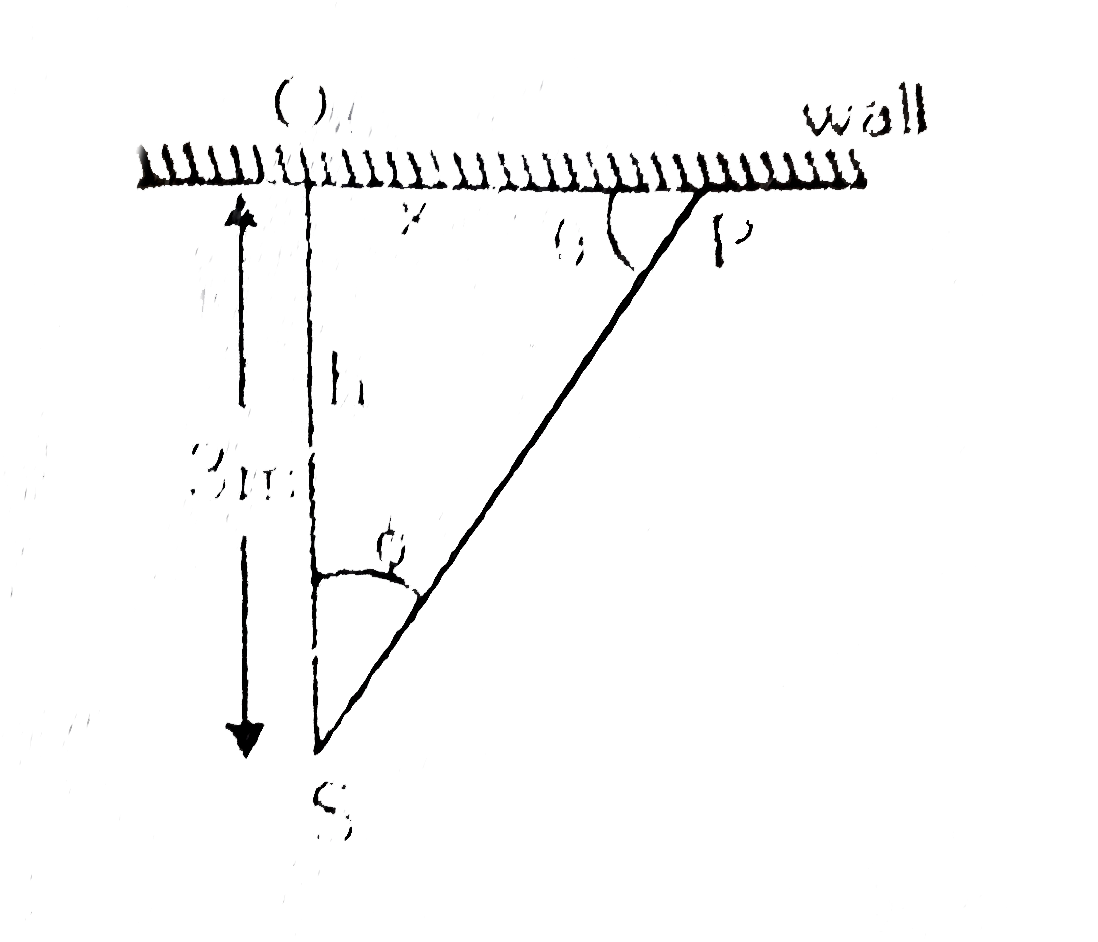A particle is kept fixed on as turntable rotating uniformly. As seen from the ground the particle goes in a circle,its speed is 30cm/s and acceleration is 30cm/s2The particle is now shifted to a new positon to make the radius half of the original value. The new values of the speed and acceleration will beSolution in Gujrati
The correct Answer is:A
Let x is the distance of point P from O, the from figure
tanϕ=xh or x=htanϕ
⇒dxdt=hsec2ϕdθdt
[dϕdt=ω]⇒v=hsec2ϕω
So putting values
h=3,ϕ=180−(90+45)=45∘
we get v=(3√2)2×0.1=0.6m/s

Topper's Solved these Questions
- BOOK - ALLEN CHAPTER - KINEMATICSEXERCISE - EXERCISE-0257videos
KINEMATICS
- BOOK - ALLEN CHAPTER - KINEMATICSEXERCISE - EXERCISE-036videos
KINEMATICS
- BOOK - ALLEN CHAPTER - KINEMATICSEXERCISE - EXERCISE-289videos
KINEMATICS
- BOOK - ALLEN CHAPTER - ERROR AND MEASUREMENTEXERCISE - Part-2(Exercise-2)(B)22videos
ERROR AND MEASUREMENT
- BOOK - ALLEN CHAPTER - KINEMATICS (MOTION ALONG A STRAIGHT LINE AND MOTION IN A PLANE)EXERCISE - BEGINNER S BOX-78videos
KINEMATICS (MOTION ALONG A STRAIGHT LINE AND MOTION IN A PLANE)
Similar Questions
A particle is moving in a plane with velocity given by →u=u0ˆi+(aωcosωt)ˆj, where ˆi and ˆj are unit vectors along x and y axes respectively. If particle is at the origin at t=0. Calculate the trajectory of the particle :-
01:03View SolutionThe equation of one dimensional motion of the particle is described in column I. At t=0, particle is at origin and at rest. Match the column I with the statement in Column II.
Column IColumn II(A)x=(3t2+2)m(p)Velocity of particle at t=1s is 8m/s(B)v=8tm/s(q)Particle moves with uniform acceleration(C)a=16t(r)Particle moves with variable acceleration(D)v=6t−3t2(s)Particle will change its direction some time01:40View SolutionA student performs an experiment to determine how the range of a ball depends on the velocity with which it is projected. The "range" is the distance between the points where the ball lends and from where it was projected, assuming it lands at the same height from which it was projected. It each trial, the student uses the same baseball, and launches it at the same angle. Table shows the experimental results.
∣∣ ∣ ∣ ∣ ∣ ∣∣TrailLaunch speed(m/s)Range(m)110822031.833070.7440122.5∣∣ ∣ ∣ ∣ ∣ ∣∣
Based on this data, the student then hypothesizes that the range, R, depends on the initial speed v0 according to the following equation : R=Cvn0, where C is a constant and n is another constant.
Based on this data, the best guess for the value of n is :-01:55View SolutionA cube has a side of length 1.2×10−2m. Calculate its volume.
01:49View SolutionA football player kicks a ball at an angle of 30∘ with an initial speed of 20 m/s. Assuming that the ball travels in a vertical plane, calculate (a) the time at which the ball reaches the highest point (b) the maximum height reached (c) the horizontal range of the ball (d) the time for which the ball is in the air, (g=10m/s2)
02:56View SolutionA particle executing S.H.M. has a maximum speed of 30 cm//s and a maximum acceleration of 60cm//s^(2) . The period of oscillation is
03:21View SolutionA particle executing SHM has a maximum speed of 30 cm//s and a maximum acceleration of 60 cm/s^(2) . The period of oscillation is
01:42View Solutionएक कण 20 cm त्रिज्या के वृत्त पर चल रहा है। इसकी चाल एकसमान दर से बढ़ती जाती है। यदि चाल 2.0 s में 5.0 m/s से 6.0 m/s हो जाती है, तो कण का कोणीय त्वरण का मान बताएँ।
01:55View Solutionएकसमान चाल से 10 cm त्रिज्या से वृत्त पर चलता हुआ एक कण 4.0 s में चक्कर पूरा कर लेता है। कण का त्वरण बताएँ।
02:32View SolutionA turn table which is rotating uniformly has a particle placed on it. As seen from the ground, the particle goes in a circle with speed 20 cm//s and acceleration 20 cm//s^2 . The particle is now shifted to a new position where radius is half of the original value . the new values of speed and acceleration will be
01:17View Solutionएक कण 25 सेमी. त्रिज्या के वृत्त में 2 चक्कर /सेकण्ड की चाल से गति कर रहा है । कण का त्वरण m/s2 में होगा
06:36View Solutionएक कण 0.5 मी त्रिज्या के वृत्ताकार पथ पर एकसमान रूप से बढ़ रही (त्वरित) चाल से चल रहा है | यदि कण की चाल 4 सेकण्ड में 2 मी/से से 10 मी/से हो जाती है, तो कण का कोणीय त्वरण ज्ञात कीजिए |
01:29View SolutionA particle executing SHM has a maximum speed of 30cm/s and a maximum acceleration of 60cm/s2. The period of oscillation is………..
03:13View SolutionA particle executing SHM has a maximum speed of 30cm/s and a maximum acceleration of 60cms2 . The period of oscillation is
02:16View Solutionसरल आवर्त गति करते हुए कण की अधिकतम चाल 30 तथा अधिकतम त्वरण 30 cm / s2 है इसका आवर्त काल है
01:58View SolutionA turn table which is rotating uniformly has a particle placed on it. As seen from the ground, the particle goes in a circle with speed 20 cm//s and acceleration 20 cm//s^2 . The particle is now shifted to a new position where radius is half of the original value . the new values of speed and acceleration will be
02:29View Solution

